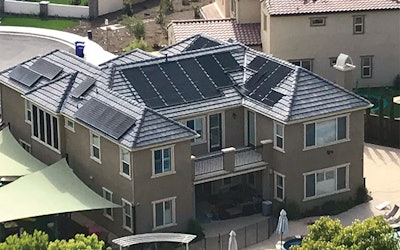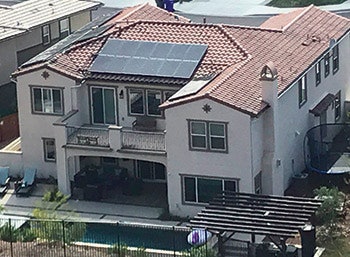

While solar heaters have maintained a steady niche in the swimming pool market, solar manufacturers and installers over the years have had to adapt to evolving technology and consumer preferences. A new technology invented by FAFCO called CoolPV, a hybrid technology that combines solar water heating with photovoltaic (PV) electrical power generation in the same panel, offers a new way to appeal to the energy-conscious pool owner.
"The concept has tremendous potential," explains Phil DelNegro, FAFCO's vice president of sales and marketing. "It combines a solar electric panel with one of our polymer heat exchangers. The heat exchangers are nested behind the PV panels, where water cools the PV collectors, which in turn makes them more efficient. The byproduct of combining PV with thermal heating is warm water. We use that warm water to heat pools. Otherwise, all that heat generated by the PV collectors would go to waste."
In addition to making solar power more efficient, the new technology solves a longstanding problem: With the advent and growing popularity of PV systems, many homeowners and businesses have been essentially forced to choose between either using solar panels to heat water or generate electricity.
The CoolPV panels do both.

SAVING AND EXPANDING
According to DelNegro, combining the two technologies yields an efficiency gain in terms of overall energy output, an advantage that plays well with energy-conscious consumers — especially those hit hardest by rising energy costs.
"By cooling the PV collectors, electrical output is increased from 2 to 20 percent, depending on the application," he says. "When you combine the electrical output with the thermal heating, the system generates four times the total energy compared to a standalone PV system — calculated by mathematically converting the Btu output on the water side of the system to watts and adding it to the PV output. Basically, we're harnessing close to all the energy we possibly can within the laws of thermodynamics. "
RELATED: Solar & VSP — Better Together
"It's a revolutionary idea," says Bryan Raymond, owner of Diablo Solar Services in Martinez, Calif. "It's the kind of thing where you wonder why no one has done this before."
Raymond speaks from experience. In business for 33 years in the East San Francisco Bay area, his company has installed more than 22,000 systems; the majority of them are solar heaters, but his firm has installed a handful of PV systems as well.
"We're extremely excited about the technology for a number of reasons," he says. "The biggest is that it enables homeowners to have it both ways. Having to choose between water heating and PV systems has been a challenge for a lot of people, and has prevented many from buying either one. Now they don't have to make that choice."
Raymond's company has worked closely with FAFCO on a number of technical refinements and has now installed 15 systems.
"Every single one of our customers we've sold it to are thrilled with the results," he says. "They love heating their pools and extending the swim season, gaining more enjoyment from their pools, and they appreciate saving money on their monthly power bill."
Unsurprisingly, because the system is roughly 25 percent more expensive than comparable solar pool heating or PV systems, it's gained the most traction with relatively affluent customers. That happens to fit well with the growth of outdoor features that consume energy, such as ancillary water features, landscape lighting, outdoor kitchens and other systems that have become commonplace among upscale homeowners.
"These days, there are more and more things people have in their homes and backyards that consume energy," Raymond says. "The system can offset the additional cost of running all the different 'toys' people have."
According to Max Day, CFO for Green Flash Energy in San Diego, which has been offering CoolPV for only six months, the initial response has far exceeded his sunniest expectations. "So far we've presented the system to 20 homeowners and businesses, and not one has said 'no,'" he says.
UP ON THE ROOF
Aside from increased energy efficiency, another significant advantage FAFCO promotes is the system's efficient use of roof space, an advantage that has become increasingly important over time.
"One of my favorite taglines is, 'You can maximize the value of your roof by minimizing your energy footprint,'" DelNegro says. "The fact is, roof space has become more and more valuable. With skylights, architectural variances in rooflines, fire codes with clearance issues for vents and chimneys, it's become more and more important to make the most of the roof space clients have. That's why the idea of getting two for one is so important."
The two-for-one concept also means space requirements are minimized, which means fewer penetrations to the roof when mounting the panels. A smaller footprint also causes less of an aesthetic impact, a common objection among homeowners.
RELATED: 4 Keys to a Solid Heater Choice
"So far, the people who seem more apt to go with the system are those who do have some kind of challenge with roof space, and they're torn between generating electricity or heating their pool," DelNegro says. "They want both but until now they couldn't have both."
"In areas like ours in San Diego County, where we've seen tremendous growth and development, roof size and appearance are extremely important," Day says. "In situations where in the past we've installed separate thermal and PV systems, the systems can look hideous once it's all in place. Now we're offering both capabilities in a system that's infinitely less visually intrusive. I really can't overstate the importance of the combination of minimizing the visual impact and offering both types of systems in one panel."
BRIGHT SKIES AHEAD
Those interviewed for this discussion all couched their glowing comments with notes of cautious optimism. Although all early indications are that CoolPV may well be poised for growth, it is still very new and long-term success will depend on a number of factors, such as the economy, consumer attitudes and energy costs.
"There's no question it's a game changer for many potential customers," Raymond says. "Most people understand that while it's expensive, as time goes on the price will continue to go down. Right now, if you want both thermal heating and PV, there's simply no other choice. Overall, it's a product I really do believe in."












































